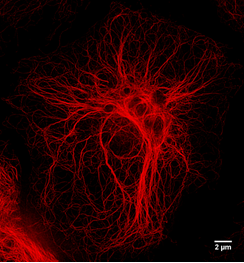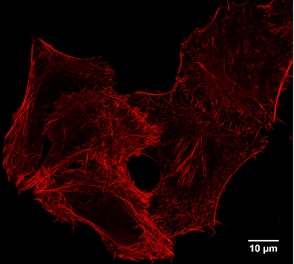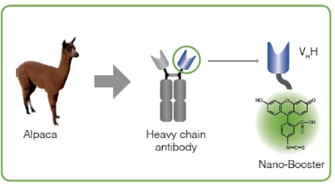First Peptide-tag specific Nanobody applied in super resolution microscopy (SRM)
This blog features that BC2 peptide-tag specific Nanobody, which ChromoTek markets under the names Spot-Label® and Spot-Trap®.
You may have noticed the recent publication “A peptide tag-specific nanobody enables high-quality labeling for STORM imaging” of Virant et al (2018) in Nature Communications doi: 10.1038/s41467-018-03191-2, where for the first time a peptide-tag specific Nanobody was applied in dSTORM imaging: The authors have described and discussed the performance of a BC2 peptide-tag specific Nanobody to image BC2 peptide tag fusion proteins in super resolution microscopy, i.e. dSTORM. This Blog features that BC2 peptide-tag specific Nanobody, which ChromoTek markets under the names Spot-Label® and Spot-Trap®. In addition, this Blog figures the significantly improved version of the BC2 peptide -tag, which is called Spot-Tag®.
Spot-Label and Spot-Trap are conjugates of the BC2-tag Nanobody
The monovalent and bivalent derivatives of the BC2 peptide-tag Nanobody, which are discussed in the publication Virant et al (2018), are available from ChromoTek. The Spot-Tag Nanobody is marketed using the product names Spot-Label, when conjugated to a fluorophore, or Spot-Trap, when conjugated to a solid matrix.
Spot-Tag is a significantly improved version of the BC2 peptide-tag
The affinity of the referenced Nanobody respectively Spot-Label/Spot-Trap to the advanced Spot-Tag peptide is significantly higher than to BC2 peptide-tag and therefore further reduces background.
What are the differences between BC2-Tag and Spot-Tag?
Four of the 12 amino acids from BC2 peptide-tag (green, top) have been replaced by rational design to form the Spot-Tag peptide (blue, bottom):

As a result, the Spot-Tag Nanobody has a higher affinity to Spot-Tag than to the BC2 peptide-tag.
Why should I use Spot-Tag instead of BC2-tag?
Because the Spot-Tag peptide is preferentially bound with low nanomolar affinity by the Spot-Tag nanobody.
Where can I obtain Spot-Tag peptide expression vectors?
You can receive Spot-Tag peptide expressions vectors free of charge from ChromoTek: Please send an email to support@chromotek.com.
Where can I buy monovalent (mono)BC2-Nb and bivalent bivBC2-Nb Nanobody in Virant et al?
What are corresponding ChromoTek product names that are referenced in Virant et al (2018)?
ChromoTek sells fluorophore conjugated Nanobodies under its product name Spot-Label. See below and/or send email to info@chromotek.com
|
Virant et al abbreviation |
Virant et al name |
Corresponding ChromoTek |
ChromoTek tested Application |
|
BC2-Nb or monoBC2-Nb |
Monovalent anti-BC2-Nanobody |
Western Blot | |
|
monoBC2-NbAF647 |
Monovalent anti-BC2-Nanobody, NHS conjugated to Alexa647 |
For Western blot we recommend |
Western Blot |
|
bivBC2- NbAF647 |
Bivalent anti-BC2-Nanobody, conjugated to Alexa647 | Spot-Label® Alexa Fluor® 647 | |
|
bivBC2- NbAF647 |
Bivalent anti-BC2-Nanobody, NHS conjugated to Alexa647 | Spot-Label® Alexa Fluor® 647 |
IF, STED |
More Spot-Label conjugates with additional fluorophores will be launched. Please inquire for updates (support@chromotek.com).
Does BC2-tag or Spot-Tag create background in immunofluorescence microscopy?
No – Background is caused by the Nanobody binding non-specifically to other proteins or peptides. Spot-Tag is a peptide that binds with an up to 10-times higher affinity to the Nanobody than the BC2-tag.
As the anti-BC2 Nanobody was originally generated against beta-catenin, Virant et al (2018) have assessed the background staining of endogenous beta-catenin. The authors conclude that the BC2-epitope of beta-catenin has only a minor impact on imaging BC2-tagged proteins. Due to its superior binding to the Spot-Tag, the Spot-Tag Nanobody causes even less beta-catenin-derived background staining when working with Spot-tagged proteins. This is strongly supported by ChromoTek’s imaging data, in which no background from endogenous beta-catenin was observed.
How is Spot-Tag characterized?
- 12 amino acid sequence: PDRVRAVSHWSS
- Size: 1.4 kDa
- pI: 10.4
- Extinction coefficient: 5,500 L·mol−1cm−1
- Expression tested in bacteria, yeast, mammalian cell lines and insect cells; other cells/organisms not tested
- Shown to work both as N-terminal and C-terminal fusion
- Biological function of the Spot-tagged fusion protein is not impaired
- High affinity, dissociation constant in low nanomolar range
Where do I find more information about the Spot-Nanobody?
See www.ptglab.com
Can Spot-Tag and Spot-Tag Nanobody be used for STED, too?
Yes, Spot-Tag and its Nanobody can be also used for STED SRM technologies. Below see two STED images using Spot-Label594, i.e. anti-Spot-Tag Nanobody, bivalent, NHS conjugated to Atto594: HeLa cells expressing Vimentin-Spot-Tag (left) and HeLa cells expressing Actin-Chromobody-Spot-Tag (right) were immunostained with anti-Spot-Label594 (1:1000). Gated STED images were acquired with a Leica TCS SP8 STED 3X microscope with pulsed White Light Laser excitation at 590 nm and pulsed depletion with a 775 nm laser. Objective: 100x Oil STED White, NA: 1.4. Pixel size: 21 x 21 nm; z-Step size of z-Stacks: 0.16 µm. Images were deconvolved with Huygens Professional (SVI). STED images were recorded at the Core Facility Bioimaging at the Biomedical Center, LMU Munich.


Why are Nanobodies particularly well suited for imaging applications?
The anti-Spot Nanobody conjugated to a fluorophore is called Spot-Label and has the smallest epitope label displacement, also called linkage error, of all antibodies when labelling a target. This is of particular importance for SRM imaging. In addition, Spot-Label has a superior tissue and cell penetration rate compared to IgGs.
Is Spot-Tag validated for other applications than IF? – What applications can Spot-Tag be used for?
Yes, Spot-Tag in combination with Spot-Trap or Spot-Label can also be used for:
- Immunoprecipitation
- Affinity protein purification (native and non-native elution conditions)
- Immunofluorescence & imaging (wide field, confocal, dSTORM, STED)
- Western blotting
What Literature has already been published?
Braun, M. B. et al. Peptides in headlock – a novel high-affinity and versatile peptide binding nanobody for proteomics and microscopy, Sci. Rep. 6, 19211; doi: 10.1038/srep19211 (2016).
Bruce, V. J. and McNaughton, B. R. Evaluation of Nanobody Conjugates and Protein Fusions as Bioanalytical Reagents, Anal. Chem. doi: 10.1021/acs.analchem.7b00470 (2017)
Virant, D., Traenkle, B., Maier, J., Kaiser, P. D., Bodenhoefer, M., Schmees, D., Vojnovic, I., Pisak-Lukáts, B., Endesfelder, U. and Rothbauer, U. 2018. A peptide tag-specific nanobody enables high-quality labeling for STORM imaging, Nature communications; doi: 10.1038/s41467-018-03191-2 (2018)